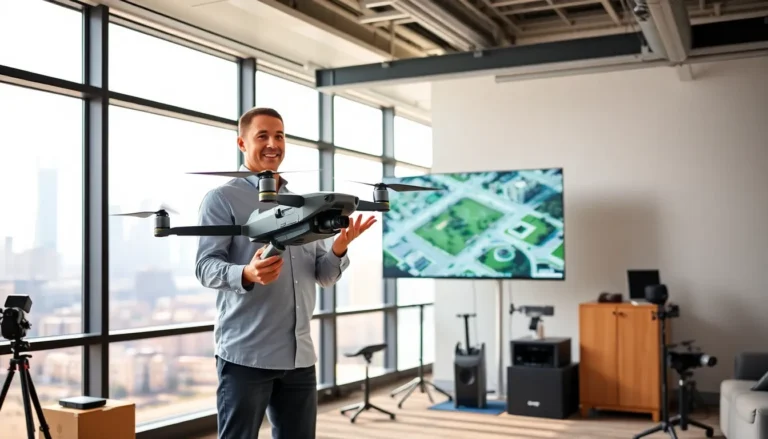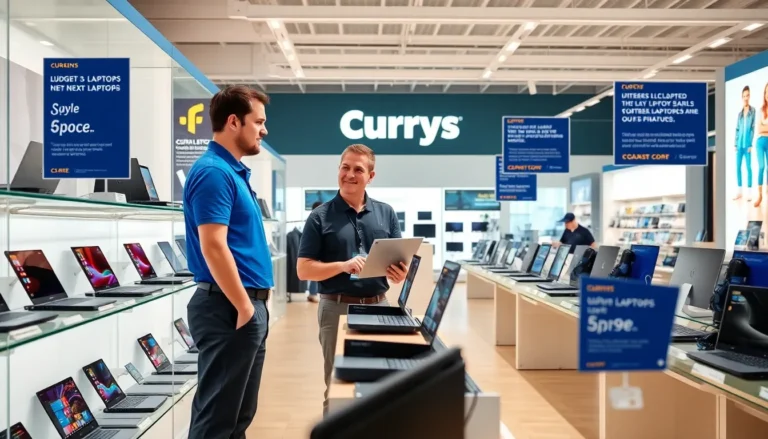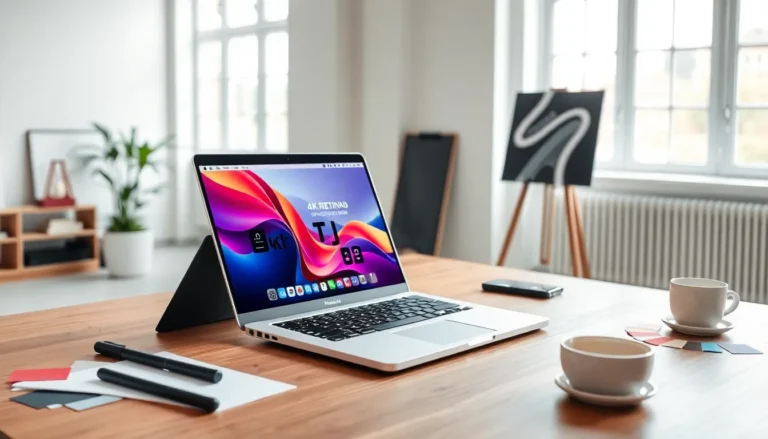Choosing the right laptop screen size can feel like picking a favorite child—everyone has an opinion, and there’s no one-size-fits-all solution. Whether you’re a casual browser, a binge-watching aficionado, or a hardcore gamer, the screen size can make or break your experience. After all, who wants to squint at a tiny display when they could be immersed in vibrant visuals?
Table of Contents
ToggleImportance Of Laptop Screen Size
Selecting the right laptop screen size significantly impacts user experience. Users engaging in activities such as photo editing benefit from larger displays, as they provide more screen space for detailed work. Meanwhile, those focused on portability often prefer smaller screens, which easily fit into bags and are lighter for travel.
Gaming enthusiasts frequently opt for screen sizes of 15 inches or larger. These sizes enhance immersion and allow for improved graphics. In contrast, students and professionals attending meetings or lectures may find that 13 inches or smaller meets their needs without excessive bulk.
Personal comfort plays a key role in screen size choices. Strain on the eyes can occur with smaller screens during prolonged use, making larger options preferable for some individuals. Ease of multitasking also improves with larger displays, allowing users to view multiple windows side by side.
Market trends reveal a growing demand for 14-inch and 15-inch laptops, reflecting a balance between display real estate and portability. Specific tasks dictate preferences; data analysts and developers favor larger screens for programming or data visualization. Content consumers lean towards larger sizes for a more enjoyable viewing experience.
Ultimately, individual workflows and lifestyle preferences dictate ideal laptop screen sizes. Understanding personal needs helps users make informed decisions that enhance usability and satisfaction.
Factors To Consider

Selecting the right laptop screen size involves evaluating several important factors. Users’ unique needs play a significant role in this decision.
Portability
Portability remains a top priority for many users. Smaller screens, typically under 14 inches, enhance ease of travel and fit comfortably in bags. Lightweight options also reduce the overall weight of the device, making them ideal for students and business professionals. Moving between locations or commuting becomes more manageable with these compact designs. Larger screens, while offering better visibility, can increase weight and bulk, making them less practical for frequent travel. Ultimately, finding a balance between display size and portability is essential for on-the-go lifestyles.
Usage Purpose
Usage purpose significantly influences the ideal screen size. Photo and video editing often requires larger displays, usually 15 inches or more, to see fine details clearly. Gamers also benefit from bigger screens, enhancing immersion and visual experience. On the other hand, casual browsing and document editing may not need expansive sizes, with 13 inches or smaller being sufficient. Professionals who prioritize multitasking appreciate larger screens for better workflow and productivity. Personal preferences and activities determine how users interact with their devices, highlighting the importance of screen size tailored to specific tasks.
Popular Laptop Screen Sizes
Choosing the right laptop screen size significantly impacts user experience. Each size category caters to different preferences and use cases.
Small Laptops (11-13 inches)
Small laptops, ranging from 11 to 13 inches, emphasize portability. These models typically weigh less than three pounds, making them ideal for students and business professionals who travel often. Users engaged in light tasks, such as web browsing and document editing, find these sizes sufficient. Battery life often extends into the full workday, enhancing convenience. Despite their compact dimensions, small laptops can still provide adequate performance for daily tasks, allowing for easy transportation without sacrificing functionality.
Medium Laptops (14-15 inches)
Medium laptops fall between 14 and 15 inches, striking a balance between functionality and portability. This category has gained popularity due to versatile use cases, including casual gaming and multimedia consumption. Screen resolution in this range usually supports full HD, enhancing the viewing experience for videos and graphics. Many professionals prefer medium laptops because they offer enough screen real estate for productivity tasks, from coding to graphic design. Ergonomics also improve with increased workspace, reducing eye strain during extended use.
Large Laptops (16 inches and above)
Large laptops, sized at 16 inches and larger, cater to users demanding immersive experiences. These devices typically excel in fields like video editing, gaming, and graphic design, where detail matters. High-resolution displays often accompany this size, providing sharp visuals and deeper color accuracy. Users benefit from larger keyboards and impressive speakers, fostering an engaging experience. Although portability decreases, the enhanced performance and screen space justify this sacrifice for serious creators and gamers who require robust capabilities.
Pros And Cons Of Various Sizes
Selecting the right laptop screen size involves weighing the pros and cons of each option. Different sizes cater to varying needs and preferences.
Advantages Of Larger Screens
Larger screens typically enhance the experience for graphic-intensive tasks. Users find 15 inches or above ideal for gaming and video editing due to the increased detail and immersion. Clarity improves significantly, allowing for more accurate color reproduction in creative work. Professionals appreciate the extra screen real estate, which facilitates multitasking. Furthermore, larger laptops often support higher resolution displays, contributing to better overall visual quality. These dimensions also reduce eye strain during long sessions, as text and images appear clearer.
Advantages Of Smaller Screens
Smaller screens, generally under 14 inches, appeal to those prioritizing portability. They typically weigh less, making them easier to carry for students and business travelers. Compact designs fit well in tight spaces, such as backpacks or briefcases. Users engaged in everyday tasks like browsing or word processing find 13 inches or smaller sufficient for their needs. Battery life often lasts longer on these devices, making them practical for on-the-go use. Additionally, smaller screens can encourage a focus on single tasks, avoiding distractions from multitasking.
Choosing the right laptop screen size is essential for maximizing user experience. It’s about balancing personal preferences with specific tasks. Whether one values portability or seeks a larger display for detailed work, understanding individual needs is key.
As the market trends toward versatile sizes like 14 and 15 inches, users can find options that cater to both functionality and ease of transport. Ultimately, selecting the best screen size can lead to greater satisfaction and efficiency in daily tasks. Making an informed choice ensures that users can enjoy their laptops to the fullest, whether for work or leisure.





